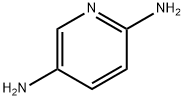2,6-Diaminopyridine
Synonym(s):2,6-Diaminopyridine
- CAS NO.:141-86-6
- Empirical Formula: C5H7N3
- Molecular Weight: 109.13
- MDL number: MFCD00006329
- EINECS: 205-507-2
- SAFETY DATA SHEET (SDS)
- Update Date: 2024-12-18 13:37:16

What is 2,6-Diaminopyridine?
Description
2,6-Diaminopyridine is an important organic reagent with a wide range of uses. It can be used for fluorescence detection, 2,6-Diaminopyridine fluorescence method for the determination of certain aromatic primary amines. It can also be used to prepare 2,6-Diaminopyridine imprinted core-shell nanoparticles. A new method for the detection of diaminopyridine derivatives using molecularly imprinted electrochemical sensors has been established, which has been applied to the detection of 2,6-Diaminopyridine in hair dyes with good sensitivity and selectivity.
Chemical properties
Off-white crystal powder/granuale
Description
2,6-Diaminopyridine functions as a reagent in chemical synthesis. It acts as a building block in the formation of various organic compounds, particularly in the production of agrochemicals, and specialty chemicals.
The Uses of 2,6-Diaminopyridine
2,6-Diaminopyridine, used as a pharmaceutical intermediate and a hair dye coupler in oxidation/permanent formulations.
Preparation
In a 600 mL autoclave equipped with a gas entrapment stirrer, a solution of 5 g CuI in 120 g aqueous ammonia (30% NH3 by weight) was added and mixed with 77 g ammonium acetate and 60 g of 2, 6-dichloropyridine. After purging with nitrogen, 24 g of liquid ammonia was added resulting in a pressure of about 150 psi (1.03 MPa). Subsequently, the reaction mixture was heated to 150°C for 8 h under stirring. Throughout the reaction, the pressure decreased from an initial pressure of 680 psi (4.69 MPa) to 450 psi (3.10 MPa). The reaction mixture was allowed to cool to room temperature, and the pressure was brought back to atmospheric pressure. Finally, 2,6-Diaminopyridine was obtained after purification.
Mechanism of action
The mechanism of action involves its ability to participate in nucleophilic substitution reactions, where it can undergo substitution with other functional groups to form new chemical bonds. Its role in chemical synthesis involves its interaction at the molecular level, where it can facilitate the formation of specific chemical structures through its reactivity with other compounds.
Safety Profile
Poison by intravenous and intraperitoneal routes. Mutation data reported. When heated to decomposition it emits toxic fumes of NOx.
Toxicity evaluation
2,6-Diaminopyridine was not mutagenic in Salmonella typhimurium strain TA98 in the
presence or absence of nonharman at 200 μg/plate. The mutagenicity of this
compound was not enhanced by rodent liver S-9 (Sugimura et al., 1982).
In another study, it was not mutagenic in S. typhimurium strain
TA98 without rodent liver S-9. However, it was mutagenic in the presence of rodent
liver S-9 (Takahashi & Ono, 1993).
This compound was not mutagenic in S. typhimurium strains TA98, TA100, and
TA1535 in the presence or absence of rodent liver S-9 (JETOC, 1997; Takahashi &
Ono, 1993)
It was mutagenic in S. typhimurium strain TA1537 in the presence
or absence of rodent liver S-9 (JETOC, 1997).
2,6-Diaminopyridine was not mutagenic in Escherichia coli strain WP2 uvrA in the
presence or absence of rodent liver S-9 (JETOC, 1997).
Properties of 2,6-Diaminopyridine
| Melting point: | 117-122 °C (lit.) |
| Boiling point: | 285 °C (lit.) |
| Density | 1.7110 (rough estimate) |
| refractive index | 1.5340 (estimate) |
| Flash point: | 155°C |
| storage temp. | Store below +30°C. |
| solubility | 180g/l |
| pka | 6.13±0.24(Predicted) |
| form | Flakes or Crystalline Powder |
| color | Beige to dark brown-gray |
| PH | >7 (H2O) |
| Water Solubility | 9.9 g/100 mL (20 ºC) |
| BRN | 108513 |
| CAS DataBase Reference | 141-86-6(CAS DataBase Reference) |
| NIST Chemistry Reference | 2,6-Pyridinediamine(141-86-6) |
| EPA Substance Registry System | 2,6-Pyridinediamine (141-86-6) |
Safety information for 2,6-Diaminopyridine
| Signal word | Danger |
| Pictogram(s) |
 Skull and Crossbones Acute Toxicity GHS06 |
| GHS Hazard Statements |
H301:Acute toxicity,oral H315:Skin corrosion/irritation H319:Serious eye damage/eye irritation H335:Specific target organ toxicity, single exposure;Respiratory tract irritation |
| Precautionary Statement Codes |
P261:Avoid breathing dust/fume/gas/mist/vapours/spray. P264:Wash hands thoroughly after handling. P264:Wash skin thouroughly after handling. P270:Do not eat, drink or smoke when using this product. P301+P310:IF SWALLOWED: Immediately call a POISON CENTER or doctor/physician. P302+P352:IF ON SKIN: wash with plenty of soap and water. P305+P351+P338:IF IN EYES: Rinse cautiously with water for several minutes. Remove contact lenses, if present and easy to do. Continuerinsing. |
Computed Descriptors for 2,6-Diaminopyridine
| InChIKey | VHNQIURBCCNWDN-UHFFFAOYSA-N |
2,6-Diaminopyridine manufacturer
ALTRAKEM PHARMA LIFE SCIENCES PRIVATE LIMITED
Sintilla Medcoms Pvt Ltd
Ralington Pharma
Madin Life Sciences Pvt Ltd
ARS ChemBlocks
New Products
Tert-butyl bis(2-chloroethyl)carbamate 4-Methylphenylacetic acid N-Boc-D-alaninol N-BOC-D/L-ALANINOL N-octanoyl benzotriazole 3-Morpholino-1-(4-nitrophenyl)-5,6-dihydropyridin- 2(1H)-one Furan-2,5-Dicarboxylic Acid DIETHYL AMINOMALONATE HYDROCHLORIDE 1,1’-CARBONYLDIIMIDAZOLE R-2-BENZYLOXY PROPIONIC ACID 1,1’-CARBONYLDI (1,2-4 TRIAZOLE) N-METHYL INDAZOLE-3-CARBOXYLIC ACID (2-Hydroxyphenyl)acetonitrile 4-Bromopyrazole 5-BROMO-2CYANO PYRIDINE 5,6-Dimethoxyindanone 5-broMo-2-chloro-N-cyclopentylpyriMidin-4-aMine 2-(Cyanocyclohexyl)acetic acid 4-methoxy-3,5-dinitropyridine 1-(4-(aminomethyl)benzyl)urea hydrochloride 2-aminopropyl benzoate hydrochloride diethyl 2-(2-((tertbutoxycarbonyl)amino) ethyl)malonate tert-butyl 4- (ureidomethyl)benzylcarbamate Ethyl-2-chloro((4-methoxyphenyl)hydrazono)acetateRelated products of tetrahydrofuran






![2-AMINO-6-[4-(2-PYRIDINYL)PIPERAZINO]-3,5-PYRIDINEDICARBONITRILE](https://img.chemicalbook.in/StructureFile/ChemBookStructure2/GIF/CB7226782.gif)

You may like
-
 2,6-Diaminopyridine 99%View Details
2,6-Diaminopyridine 99%View Details
141-86-6 -
 2,6-Diaminopyridine 98%View Details
2,6-Diaminopyridine 98%View Details -
 2,6-Diaminopyridine, 98% CAS 141-86-6View Details
2,6-Diaminopyridine, 98% CAS 141-86-6View Details
141-86-6 -
 2,6-Diaminopyridine CAS 141-86-6View Details
2,6-Diaminopyridine CAS 141-86-6View Details
141-86-6 -
 2,6-Diaminopyridine CAS 141-86-6View Details
2,6-Diaminopyridine CAS 141-86-6View Details
141-86-6 -
 141-86-6 2,6-Diaminopyridine 99%View Details
141-86-6 2,6-Diaminopyridine 99%View Details
141-86-6 -
 2,6-Diaminopyridine CAS 141-86-6View Details
2,6-Diaminopyridine CAS 141-86-6View Details
141-86-6 -
 2,6-Diaminopyridine CAS 141-86-6View Details
2,6-Diaminopyridine CAS 141-86-6View Details
141-86-6